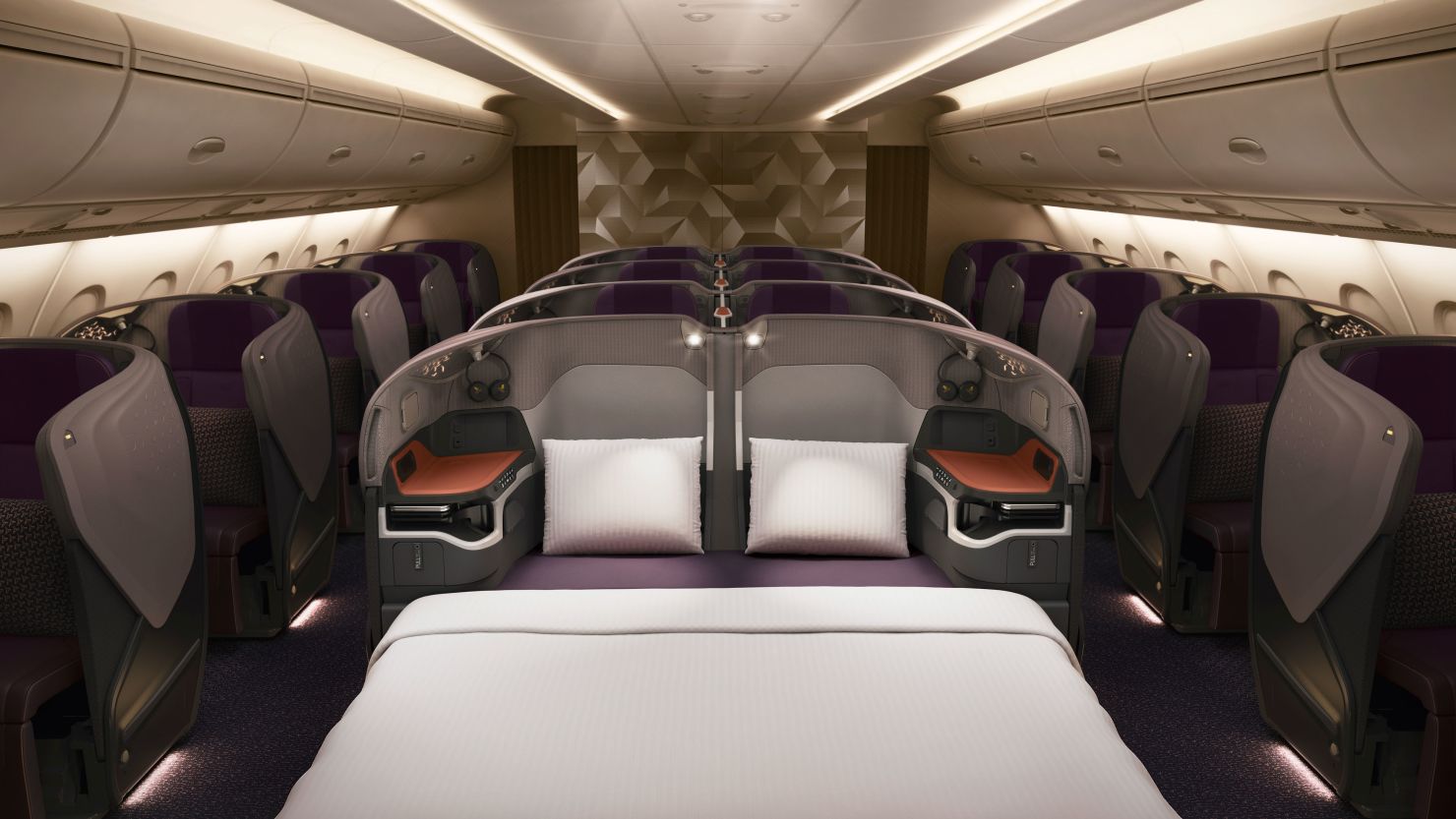Editor’s Note: Sign up for Unlocking the World, CNN Travel’s weekly newsletter. Get news about destinations opening, inspiration for future adventures, plus the latest in aviation, food and drink, where to stay and other travel developments.
As the aviation industry looks towards a future with more videoconferencing and fewer business travelers filling business class seats, it’s wooing upmarket leisure passengers to fill the gap.
Airlines are hoping that more business travelers will bring along their partners for “blended” or business-leisure – “bleisure” – travel. Yet most business class cabins were designed with the goal of privacy rather than being able to cuddle up next to Pat from accounting.
Enter a new generation of design that allows two business class seats to be converted into a double bed better suited to couples.
“Covid was an epic reset button,” explains Daniel Baron, a cabin designer and the managing director of airline design house LIFT Aero Design in Tokyo. “It shifted the priorities for many travelers. More people now long for things that might have seemed less important before the world turned upside down.
“They want a slightly slower pace, with creature comforts along the way, and meaningful experiences on the other side. Ditto for business travelers. Yes, career is still important, but time with loved ones need not be sacrificed. The trend to mix business with pleasure lends itself to an increase in demand in the premium leisure category.”
In ultra-swanky international first class, double beds have been the norm since the mid-2000s, with perhaps the most famous being Singapore Airlines’ Airbus A380 first class, and later the Etihad Residence one-bedroom suite in the mid-2010s, with a small double bed in its own room.
“Traditionally,” Baron says, “in business class there was an expectation of wide, fixed armrests on both sides of the passenger, with multiple stowage spaces. Large movable dividers were also associated with first class, not business.
“At the end of the day, it is about providing an experience that drives repeat business and positive word of mouth. The industry has shifted from ‘give me total privacy’ in business class to ‘give me options’. Airlines have realized that offering the ability to get that close can be a competitive advantage.”
There’s just something truly delightful about snuggling down with your arms around your special someone as the gentle hum of the aircraft lulls you to sleep.
The beds in business
The magic that converts a fully walled suite into a double bed revolves around two centers: first, the center section of seats between the two aisles of wide-body aircraft, and second, the center divider between the two premium seats in that center section (whether that is just in one row, in every other row, or throughout the cabin).
In practice, the flight attendants retract the wall to below the bed level, add a mattress pad and linens, and you have a first class double bed.
And now, the double bed is coming to business, although the design and logistics get more complicated because passengers have less room than in first – although, of course, still a ton more than in economy.
On the plus side, though, very few airlines charge any extra for couples to select the double bed over regular business class seats, so keep an eye on those seat maps! As a rough guide, business class these days is some four to six times the price of economy.
The modern kind of business class seats overlap cleverly with the passenger in front to provide direct aisle access to every passenger without needing the amount of space of first class.
They usually do it via the trick of one passenger’s side table also being the footwell cubby where the feet of the passenger behind go in bed mode, whether via a staggered configuration or with the seats angled in a herringbone layout.
Here’s how some of the airlines that offer double beds in business class do it.
Singapore Airlines offers a double bed option on the seats on board its fully refitted Airbus A380 fleet. All the center pairs on this layout have the option to drop the divider about as far as waist height, but the front row seats in each section are best: these (seats 11D+F, 91D+F, and 96D+F) don’t have the center divider so you’re not limited to above-waist cuddling.
Qatar Airways offers double beds as part of its QSuite product, which appears on some of its Boeing 777 and Airbus A350 planes, where in the center sections the seats stagger from being next to each other in the very middle in one row to being right next to the aisle in another. Airlines and business class regulars refer to this as the “honeymoon/divorce” layout.
However, if you look at the seat map, you quickly realize that these “honeymoon” seats can only make up about a quarter of all the seats in the cabin. That’s often not enough for an airline that’s looking to boost its premium leisure market.
Qatar Airways’ business suites on its Boeing 787 are an entirely different kind of seat, where the center sections are angled toward the aisle. That means passengers in these are shoulder-to-shoulder between the center divider. So when the center divider retracts, there’s a rather appropriately heart-shaped section where you can kiss your sweetheart goodnight.
Think of these as a quite modest above-waist snuggling class, if you will.
More and more airlines and seating manufacturers are focusing on this kind of business class double bed when they choose and make new seats.
And there’s more to come, says LIFT Aero Design’s Daniel Baron: “for sure, the next chapter is honeymoon suites on long-haul narrow-body aircraft.”
Top image: Business class on a Singapore Airlines A380R features a double-bed option. (Singapore Airlines)



